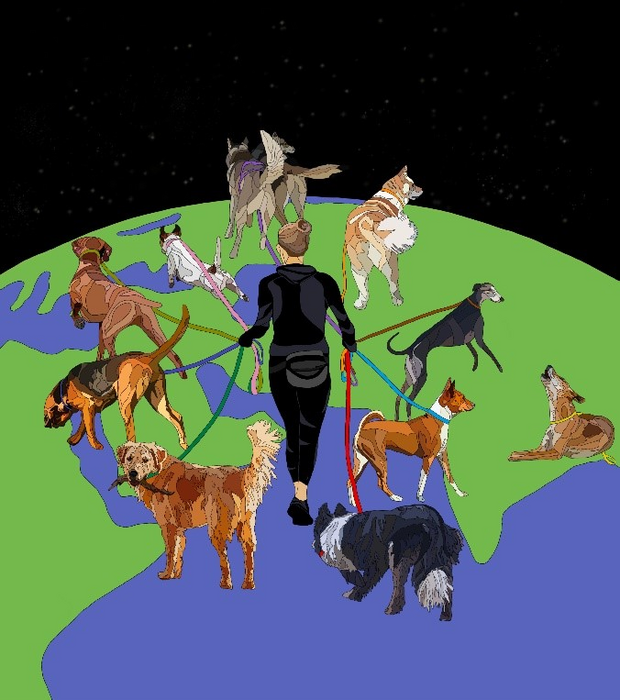From the excitable sheep dog to the aloof Shiba Inu, and all breeds in between, dogs have unique and diverse behavioral traits. By analyzing DNA samples from over 200 dog breeds along with nearly 50,000 pet-owner surveys, researchers at the National Institutes of Health have pinpointed many of the genes associated with the behaviors of specific dog breeds. Their work appears December 8th in the journal Cell.

Credit: Emily Dutrow
From the excitable sheep dog to the aloof Shiba Inu, and all breeds in between, dogs have unique and diverse behavioral traits. By analyzing DNA samples from over 200 dog breeds along with nearly 50,000 pet-owner surveys, researchers at the National Institutes of Health have pinpointed many of the genes associated with the behaviors of specific dog breeds. Their work appears December 8th in the journal Cell.
“The largest, most successful genetic experiment that humans have ever done is the creation of 350 dog breeds,” says senior author Elaine Ostrander, founder of the Dog Genome Project at the National Human Genome Research Institute. “We needed dogs to herd, we needed them to guard, we needed them to help us hunt, and our survival was intimately dependent on that.”
“Identification of the genes behind dog behavior has historically been challenging,” says first author Emily Dutrow, postdoctoral fellow at the National Human Genome Research Institute. “The inherent complexity of canine population dynamics features varying degrees of selective pressure for aesthetic and morphological traits, some of which may be linked to behavioral traits, so pinpointing the genetics of canine behavior can be complicated.”
Kennel clubs generally categorize dog breeds on the basis of the jobs they are best suited for. To find the genetic drivers of the behavioral tendencies that make dogs good at specific tasks, the researchers gathered whole-genome data from over 4,000 purebred, mixed-breed, and semi-feral dogs, as well as wild canids. By applying computational tools originally developed for studying single cells rather than whole organisms, Dutrow and team identified 10 major genetic lineages among hundreds of dog breeds, solely on the basis of DNA data. The researchers found that each lineage corresponded to a specific category of breeds historically used for tasks such as hunting by scent versus sight or herding versus protecting livestock, indicating that common sets of genes were responsible for behaviors among dog breeds well suited for similar tasks.
To understand the nature of these behaviors, the researchers turned to individual dog experts: pet owners. Using 46,000 behavioral assessment surveys sent to owners of purebred dogs, the researchers identified unique sets of behavioral tendencies among the 10 lineages of dogs. For example, behaviors associated with increased prey drive were associated with the terrier lineage, which contains breeds historically used for catching and killing prey.
“Having established significant behavioral tendencies correlated with the major canine lineages, we then identified genetic drivers of these behaviors by performing a genome-wide association study on the DNA samples,” says Dutrow. “We were particularly interested in livestock-herding dogs, who display one of the most easily defined breed-typical behaviors, characterized by an instinctive herding drive coupled with unique motor patterns that move herds in complex ways.”
The researchers’ search led them to specific genes involved in brain wiring in herding dogs. They found that variants near genes involved in axon guidance, a process that shapes brain circuitry, appeared highly enriched. They also saw an enrichment for genes important for development of areas of the brain involved in social cognition and learned fear responses.
“When you get a certain input or stimulus, the degree to which that creates a reaction in different parts of the brain shapes how we behave,” says Ostrander. “So, if nerves within and between brain regions don’t communicate in specific ways, then the behavior doesn’t happen, and this is where axon-guidance genes come in to play.”
Genetic variants associated with sheep dogs are often located near genes involved in ephrin signaling, an axon-guidance process that is involved in brain development and is implicated in behavior in other species, including humans. For example, the sheep-dog-associated gene EPHA5 has also been associated with human attention-deficit hyperactivity disorder (ADHD) and anxiety-like behaviors in other mammals. These findings could help us understand the high energy requirement of sheep dogs and their hyper focus when given a task.
“The same pathways involved in human neurodiversity are implicated in behavioral differences among dog lineages, indicating that the same genetic toolkit may be used in humans and dogs alike,” says Dutrow.
“Emily’s methodology allowed her to capture the different histories of dog breeding across the world, in one approach, one experiment, and without prior assumptions,” says Ostrander. “After 30 years of trying to understand the genetics of why herding dogs herd, we’re finally beginning to unravel the mystery.”
###
Financial support was provided by the Intramural Program of the National Human Genome Research Institute.
Cell, Dutrow et al., “Canine lineages reveal genetic drivers of dog behavioral diversification.” https://www.cell.com/cell/fulltext/S0092-8674(22)01379-4
Cell (@CellCellPress), the flagship journal of Cell Press, is a bimonthly journal that publishes findings of unusual significance in any area of experimental biology, including but not limited to cell biology; molecular biology; neuroscience; immunology; virology and microbiology; cancer; human genetics; systems biology; signaling; and disease mechanisms and therapeutics. Visit http://www.cell.com/cell. To receive Cell Press media alerts, contact [email protected].
Journal
Cell
DOI
10.1016/j.cell.2022.11.003
Method of Research
Observational study
Subject of Research
Animals
Article Title
Canine lineages reveal genetic drivers of dog behavioral diversification
Article Publication Date
8-Dec-2022




